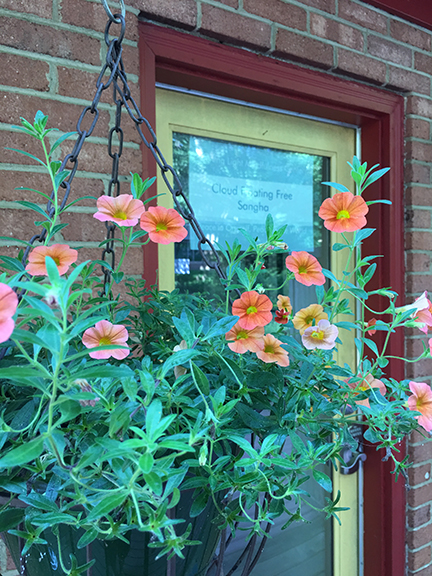Walk With Me Screening in Cville
|
|
#233 The Sun Always Shines
Your True Home, Everyday Wisdom of Thich Nhat Hanh
When it is raining, we think there is no sunshine. But if we fly high in an airplane and go through the clouds, we rediscover the sunshine again. We see that the sunshine is always there. In a time of anger or despair, our love is also still there. Our capacity to communicate, to forgive, to be compassionate is still there.
You have to believe this. We are more than our anger; we are more than our suffering. We must recognize that we do have within us the capacity to love, to understand, to be compassionate. If you know this, then when it rains you won’t be desperate. You know that the rain is there, but the sunshine is still there somewhere. Soon the rain will stop, and the sun will shine again. Have hope. If you can remind yourself that the positive elements are still present within you and the other person, you will know that it is possible to break through, so that the best things in both of you can come up and manifest again.
 As human beings, we’re exactly the same. But the many layers of labels prevent other people from seeing you as a human being. Thinking of yourself as or calling yourself a “Buddhist” can be a disadvantage, because if you wear the title “Buddhist” this may be an obstacle that prevents others from discovering the human being in you. The same is true whether you are
As human beings, we’re exactly the same. But the many layers of labels prevent other people from seeing you as a human being. Thinking of yourself as or calling yourself a “Buddhist” can be a disadvantage, because if you wear the title “Buddhist” this may be an obstacle that prevents others from discovering the human being in you. The same is true whether you are
Christian, Jewish, or Muslim. This can be an important part of your identity, but it is not the whole of who you are. People are caught in these notions and images, and they cannot recognize each other as human beings. The practice of peeling away all the labels so that the human being can be revealed is truly a practice of peace.
Your True Home the everyday wisdom of Thich Nhat Hanh
GO BACK TO THE BODY
Breathing mindfully takes our mind back to our breath and, if we continue, to our whole body. We go back to our body and reconcile with it. We get to know what’s going on in our body, the wrongs we have done, the conflicts we’re having, and we’ll know what to do and what not to do in order to be on good terms with our body. With mindful breathing, we come to recognize our body as our home. We might say:
Breathing in, I am aware of my body.
Breathing out, I smile to my whole body.
—Your True Home: The Everyday Wisdom of Thich Nhat Hanh
A message from Plum Village.
Dear Dharma Brothers & Sisters,
We’re very happy to announce the publication next week, on June 6, of Thay’s book THE ART OF LIVING, an edited selection of Thay’s unpublished teachings from 2013-14. It includes Thay’s remarkable teachings from the June 2014 21-day Retreat in Plum Village, France (the last 21-day retreat taught by Thay), with the theme “What happens when we die? What happens when we’re alive?” So perhaps the title of the book could also be, “THE ART OF LIVING AND DYING”
We hope those of you who were at the 21-Day Retreat will appreciate reading a full exposition of Thay’s teachings on the Cosmic Body, reincarnation, life-force, and so on. And those who missed the retreat will have a chance to discover some of Thay’s precious teachings before his stroke.
In THE ART OF LIVING, Thay’s insights are set within the context of the Seven Concentrations he focussed on in the last year or two of his teachings: combining the 3 Doors of Liberation with the last 4 Exercises of Mindful Breathing (making a total of 7).
We are grateful for the support of HarperOne publishing, in allowing us to produce an accessible yet profound Dharma book, that we hope will be an inspiration for Thay’s students everywhere, and a support for the deepening of our collective practice.
We hope that many of you will have a chance to read and study the book, as individuals and as sanghas. We invite you to get involved by writing an honest review on THE ART OF LIVING Amazon page, and by participating in discussions on the book’s Goodreads page. We’d especially love to see comments and reviews from those of you who attended the 2014 21-Day Retreat, and who’ve already had a chance to put these teachings into practice.
Perhaps, in the future, monastic and lay Dharma Teachers may be able to offer some structured study of the book, along the lines of Br Phap Hai’s wonderfully successful “The Sun My Heart” Book Club. If you have any ideas for this, please let us know.
We welcome your feedback.
With gratitude and appreciation,
Sister True Dedication
on behalf of the Plum Village Editorial Team